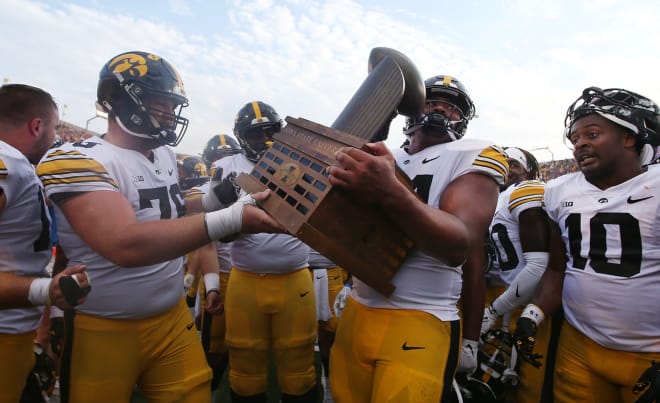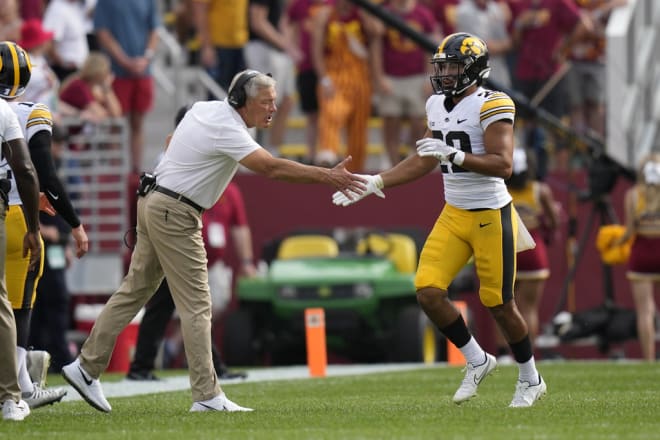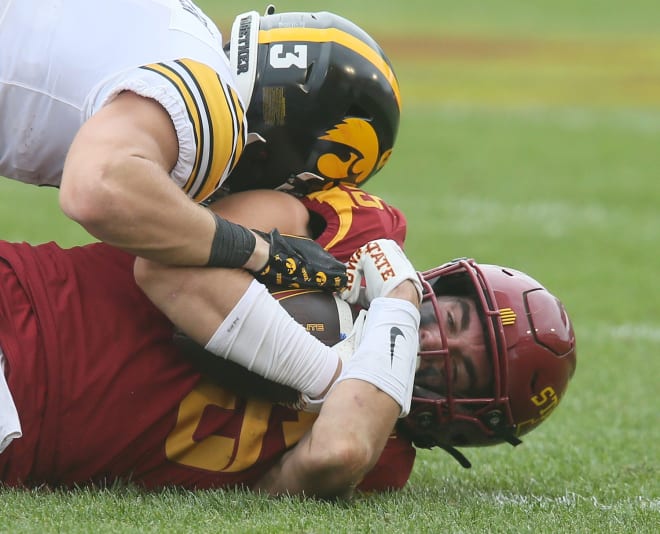Iowa 20, Iowa State 13: Five Takeaways

What stood out from Iowa's 20-13 win over Iowa State on Saturday? Let's dig into a few of the biggest takeaways from the game.
JAZIUN PATTERSON EMERGES
Let's start with a positive note: if there was a standout player for Iowa on offense today, it was definitely redshirt freshman Jaziun Patterson. Patterson led Iowa in rushing, with 86 yards on 10 carries. 59 of those yards came on an explosive chunk play on third-and-2 in the first quarter.
That play directly set up Iowa's field goal attempt a few plays later.
Patterson also scored Iowa's only offensive touchdown of the game with a sharp 4-yard run early in the second quarter:
Patterson's standout players weren't limited to running the ball, either -- he also showed good chops as a blocker, highlighted by a standout play in which his cut block took out not one, but two Cyclone defenders.
Patterson added a few more solid runs in the fourth quarter and, overall, looked like a back who can be an effective part of Iowa's offense. He ran hard, he ran with a mean streak, and -- maybe most importantly -- he ran decisively. There was no hesitation from Patterson when he got the ball. That's an approach that works well with Iowa's offensive scheme.
READ MORE: Iowa Running Game Improves Behind OL Effort and Jaziun Patterson

OFFENSIVE ISSUES
For the second straight game, the Iowa offense scored points on its first two drives of the game -- a field goal on the first drive, followed by a touchdown on the second drive to open up a 10-0 lead. For the second straight game, the Iowa offense also went into a prolonged funk after those scores.
In the second quarter, Iowa totaled 25 yards of offense on 13 plays, an average of 1.9 yards per play. After scoring a touchdown on the third play of the quarter, the offense went three-and-out on its next two possessions, before Cade McNamara threw an interception on Iowa's final possession before halftime. (The interception probably should have been negated by defensive pass interference, but that pass came on 3rd-and-8, so the Iowa offense wasn't exactly humming prior to the turnover, either.)
The production in the third quarter was a little better -- 67 yards on 16 plays, an average of 4.2 yards per play. Iowa's third and final scoring drive came in the third quarter as well, an 11-play, 69-yard field goal drive that gave the Hawkeyes a 20-3 lead.
That drive was notable for breaking tendencies -- Iowa mixed up the run and the pass on first down (two runs, two passes) and used several 5-wide, empty backfield formations (McNamara was 4/4 for 34 yards on those plays, all passes). That drive was the only time after the first quarter in which the Iowa offense had a drive that: a) went longer than six plays (there were five three-and-outs after the first quarter) and b) resulted in points.
There is unquestionably considerable room for improvement for the Iowa offense from this performance. And yet... there were some positive signs, too. The run blocking, while still inconsistent, was very effective in spurts and helped open a few big holes for Patterson. McNamara's final line -- 12/22, 123 yards, 0 TD, 1 INT -- is not impressive, but he also narrowly missed a pair of touchdown passes in the third quarter.
The first came on Iowa's lone scoring drive in the second half. On the third down prior to Drew Stevens' field goal, McNamara tried to thread a pass to Luke Lachey in the end zone -- it fell incomplete, largely because of a mix-up between Lachey and fellow tight end Addison Ostrenga that led to them running into each other in the end zone. Fullback Hayden Large was also wide open in the flat if McNamara had looked to check it down on that play -- if the play is run cleanly by Lachey and Ostrenga or McNamara dumps it off to Large, that play is likely a touchdown and Iowa doesn't have to settle for a field goal (a net gain of four points).
The second missed touchdown pass came on Iowa's next possession. Backed up to their own 9-yard line, Brian Ferentz made a great play call -- a deep throw to Seth Anderson after a double move. Anderson executed the double move well and left his defender turned inside out. But McNamara, whose throw was slightly rushed by some ISU pressure, overthrew Anderson. Iowa punted two plays later. If McNamara hits Anderson in stride, that's likely a 91-yard touchdown.
If those plays are converted, McNamara's line would have been 14/22 for 230 yards, 2 TD, and an interception, which would look a lot better. Iowa also would have been up 31-3, which would have made the fourth quarter much less stressful. Obviously, at the end of the day those plays weren't made, which is what counts -- the offense needs to make more plays, full stop. But they're also very close to making some of those plays.

SUPERB SECONDARY
Going to keep this fairly brief but the Iowa secondary was, in a word, sensational. Just look at these stat lines:
* Cooper DeJean: 10 tackles (6 solo), 0.5 tackles for loss, 1 pass break-up
* Deshaun Lee: 9 tackles (4 solo), 2 passes broken up
* Sebastian Castro: 4 tackles (3 solo), 1 interceptions (1 touchdown)
* Quinn Schulte: 6 tackles (2 solo), 1.0 tackles for loss
(Xavier Nwankpa was not credited with any tackles, but was credited with a pass break-up, which was probably also the play in which he inadvertently broke up DeJean's efforts to intercept the ball.)
DeJean seemed to be everywhere all game, smothering any and all Cyclones who were in his vicinity. He didn't have any interceptions, but his sure tackling and ability to break up passes (as he did late in the game) were key parts of the defense's overall excellent performance.
Lee was targeted often by ISU quarterback Rocco Becht, but he held up well against all of that attention. His tackling was solid and he was able to break up two passes, as well as disrupting a few more.
Castro's pick-six ended up being the game-winning score in the game; it was also his first career interception (and second career touchdown).
That play was a testament to Phil Parker's coaching and Castro's ability to take what Parker has taught him and implement it on the field. He recognized the play and jumped the route perfectly, leading to an easy interception and touchdown. Outside of that play, he was his usual strong tackler and disruptive force for the Iowa defense as well.
READ MORE:
Iowa 20, ISU 13: Castro, Defense Ring Up Another Score in Cy-Hawk Victory

THE IN-STATE EDGE
Speaking of DeJean: one thing that stood out about this win, especially late in the game, was the key roles that several in-state players had in securing this victory. DeJean, an Odebolt native, was excellent from start-to-finish in this game (as detailed in the previous section).
Joe Evans, an Ames native, played like his hair was on fire all game -- he was officially credited with five tackles, one tackle for loss, a pass break-up, and two quarterback hurries, but he was a frequent source of pressure in the ISU backfield. His pass break-up came at a key moment late in the game as well. He was an extremely active, extremely disruptive presence on Iowa's defensive line in this game.
Cedar Rapids native Ethan Hurkett finished with five tackles and two tackles for loss -- with the biggest coming at the very end of the game, as he blew up Cartevious Norton's fourth down rushing attempt.
That stop behind the line of scrimmage resulted in a turnover on downs and assured Iowa of a victory.
To be clear, plenty of players from outside the state of Iowa also played key roles in getting this win -- including Patterson (a Florida native), Lachey and All (Ohio natives), McNamara (a Nevada native), Logan Lee (an Illinois native), and Drew Stevens (a South Carolina native), among others. But several of the in-state guys seemed to play with an extra edge today -- winning this game and regaining the Cy-Hawk Trophy seemed to really mean a lot to them.

KEY UPDATE: TURNOVERS AND SPECIAL TEAMS
The turnover battle and the special teams showdown were two things that we identified as key factors in the game earlier this week. Did those aspects of the game end up playing a a key role in the outcome? Yes and no. The overall turnover margin was a wash -- Iowa and Iowa State each had an interception (almost on back-to-back plays, no less).
Still, it's fair to say that the turnover category still tilted in Iowa's favor since the turnover the Hawkeyes forced was a pick-six by Sebastian Castro. In a game that ended up being decided by seven points, that defensive score certainly feels significant.
As far as special teams, that category was essentially a push as well. Drew Stevens made both of his field goal attempts for Iowa, while Chase Contreraz converted two of three field goals for the Cyclones. Iowa did get a bit more out of the return game -- 38 yards on two kickoff returns and five yards on two punt returns (versus four yards on three punt returns and zero kickoff return yards for Iowa State).
But the Cyclones ended up with a slight edge in the punting department. Both teams punted six times in the game, but Tyler Perkins' punts went a bit further than Tory Taylor's punts did (51.8 yards per punt versus 46.3 yards per punt), and he was able to place three of his kicks inside the 20-yard line, while just two of Taylor's six punts were downed inside the 20.
Taylor's last punt of the day was also an uncharacteristically poor 35-yard effort as well; it didn't end up impacting the outcome since the Iowa defense made that fourth down stop to end the game, but he wasn't able to pin Iowa State quite as deep as you would have hoped for in that moment.